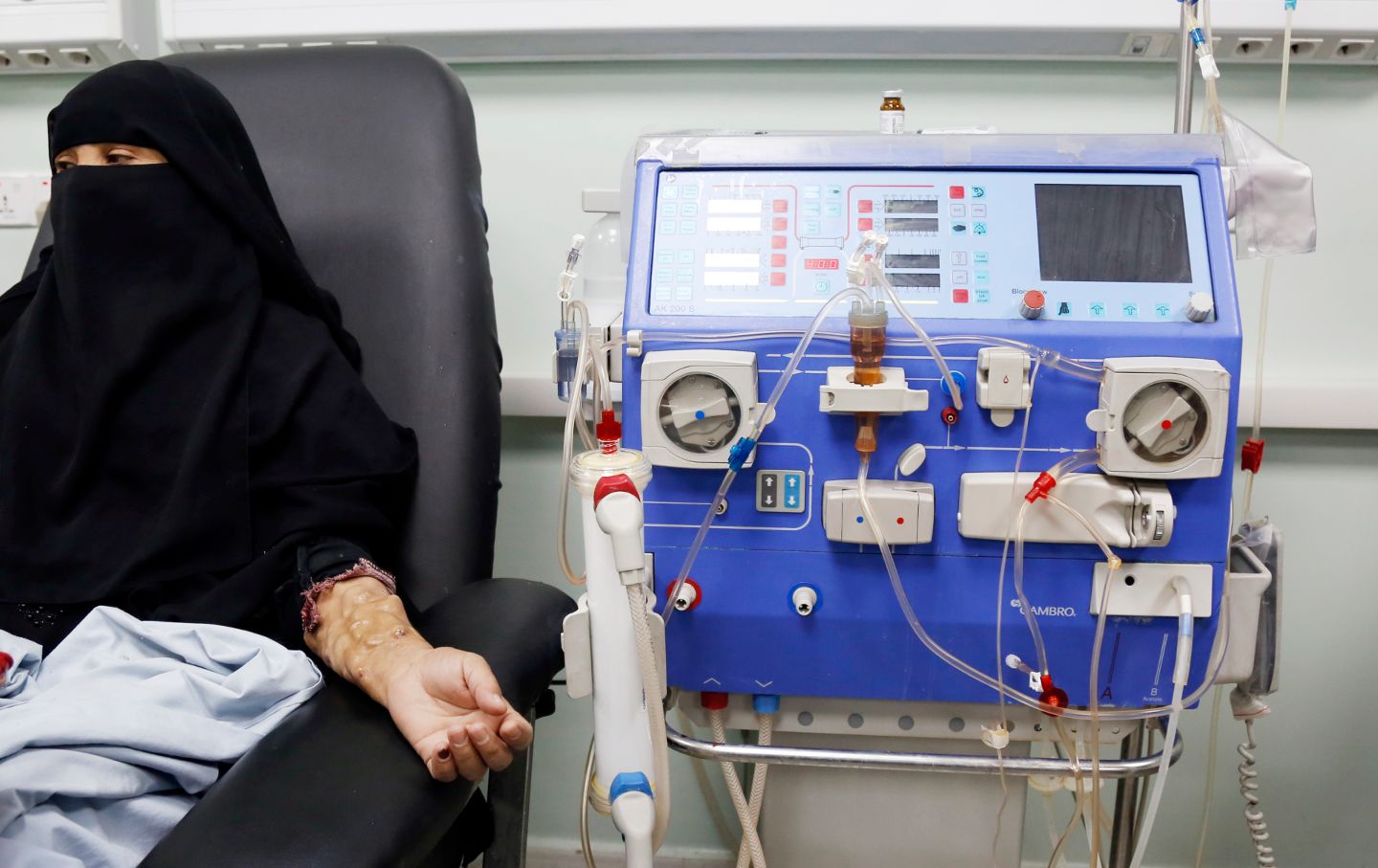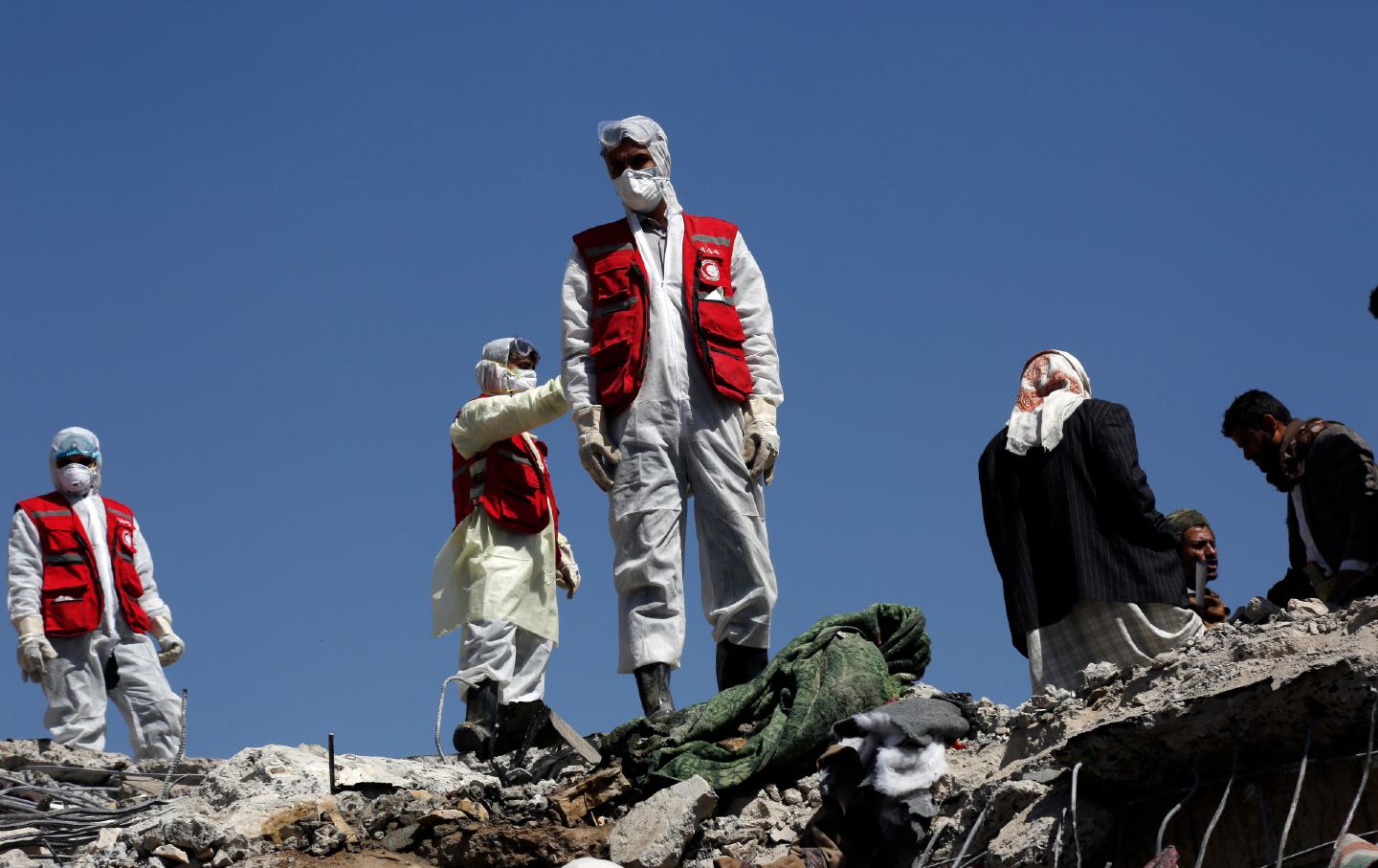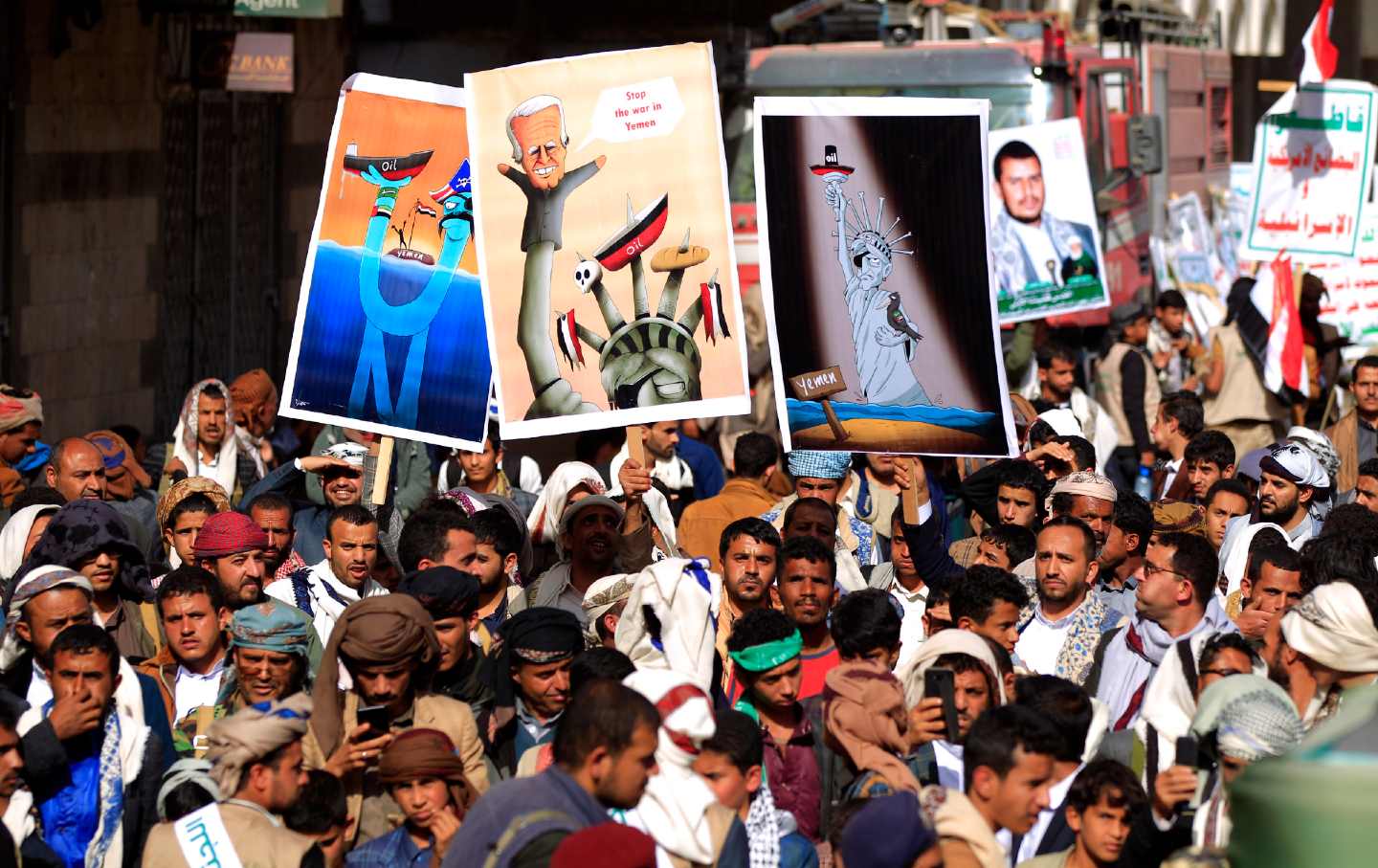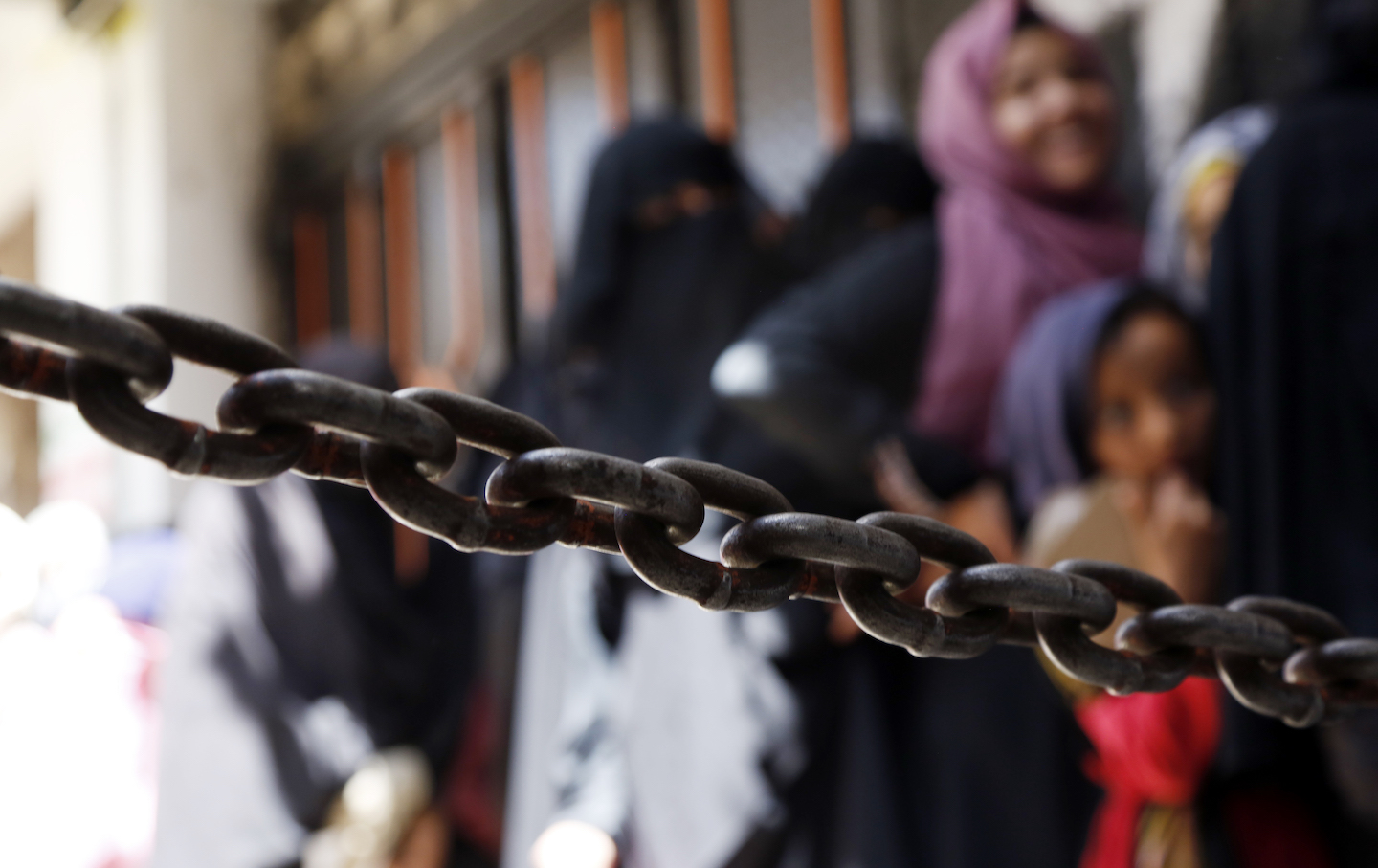Biden Says There’s No Blockade. Tell That to Yemenis Who Need Medical Care.
There are just three flights leaving Sana’a every week. But Yemen has an estimated 71,000 cancer patients who need out-of-country care.

SANA’A, Yemen—Raneem Isa Muhammad Jaber dreams of swinging in a playground or participating in a popular pastime called sahlilah, in which children use cut plastic containers to skate down a hill. “I want to play all the games, but I can’t,” said the 11-year-old, who has suffered since birth from a skin condition that leaves black spots all over her body and an itchy and painful black tumor-like growth that covers her backside. “I can’t sit down, I can’t walk, and I can’t sleep.”
She lives in the Yemeni port city of Al Hudaydah, which opens to the Red Sea. Her family is poor, but used to scrape together funds—often provided by local donors—to travel to India, the most affordable nearby option for medical care after years of war decimated Yemen’s health system. There, surgeons would excise growths from her body. Her medical providers say that she should return every six months. But her father, Isa Muhammad Jaber, said the last time she went was in 2018.
The closest international airport that doesn’t require Raneem to make the dangerous and expensive journey from the Houthi-controlled areas where she lives to those under the authority of the Presidential Leadership Council (PLC) is in the city of Sana’a. A Saudi-led military coalition, which includes the United States, bombed that airport multiple times during the war, and closed it to commercial flights.
In April 2022, Saudi Arabia entered into a truce with the Houthis and, working with the United Arab Emirates, another country on the Saudi side of the war, established the PLC. This eight-member council came to power without an election, replacing President Abd-Rabbu Mansour Hadi. The United States now considers this the “internationally recognized government” of Yemen. The truce was supposed to reopen Sana’a airport to commercial air travel, a development that has been touted by the Biden administration as proof of progress in a humanitarian crisis for which the US bears considerable responsibility.

But there are so few flights that the truce hasn’t changed anything for Raneem’s family. The PLC permits only three round-trip flights a week from Sana’a airport (down from six in June). They are all operated by a single airline, Yemenia Airways, which charges around $720 for a round-trip ticket to Jordan. (Yemenia is partially owned by the Saudi government.) And the flights only travel to and from Amman, Jordan, save for some limited trips for pilgrims to Jeddah, Saudi Arabia. In Amman, medical care is much more expensive than it is in India and Egypt. Of Yemen’s 30 million people, an estimated 80 percent “require some form of humanitarian or protection assistance,” according to the United Nations.
For those who do not have the funds and need medical care outside of the country, those flights might as well go nowhere.
The PLC obtains its legitimacy and firepower from the Saudi-led military coalition that bombed Yemen for eight years, and imposed an aerial and naval blockade on the country. The Biden administration says that this blockade does not exist. “For one year, Yemenis have benefitted from a halt to airstrikes, regular civilian flights from Sana’a airport, enhanced and unrestricted humanitarian and food assistance, and the increased flow of fuel to northern Yemen,” said Vedant Patel, principal deputy spokesperson for the State Department, in an April 2023 statement marking the first anniversary of the truce.
And while some incremental improvements have been made, particularly with respect to fuel and food imports, they fall far short of meeting the needs of a country devastated by a war in which the Saudi-led coalition repeatedly targeted civilian infrastructure like mosques, schools, hospitals, and markets. Today, Yemen is the site of one of the world’s worst humanitarian crises: 21.6 million people need humanitarian assistance; 17 million are food insecure; and 2.2 million children under 5 need treatment for acute malnutrition, according to the World Food Programme.
And crucially, freedom of movement remains curtailed for the majority of Yemenis. Raneem is one of tens of thousands of people essentially trapped inside a country where they cannot get the medical treatment they need. The blockade may not exist for the Biden administration, but it exists for her.
“I wish I could be healed,” she said over the phone.
An arduous journey
Raneem is not alone. According to the Health Ministry of Sana’a (where the Houthis are the dominant power), some 71,000 cancer patients and 8,000 kidney-failure patients need care outside of Yemen. In August 2019, the Norwegian Refugee Council, a humanitarian organization, reported that in the three years since Sana’a airport was closed to commercial flights (starting August 9, 2016), “as many as 32,000 people may have died prematurely because they were unable to travel abroad for treatment, according to the Ministry of Health in Sana’a.” The extremely limited United Nations mercy flights permitted to leave Sana’a airport in 2020 barely began to meet these needs.
Following the truce, the first commercial flight in nearly six years took off in May 2022 from Sana’a airport to Amman. Since then, a few flights between Sana’a and Amman have been allowed each week, and in June this number increased to six. But the director of Sana’a airport said July 14 on Twitter that flights out of Sana’a are back to three a week, and records kept by the UN Office of the Special Envoy of the Secretary-General for Yemen show a reduction in flight frequency in July that corresponds with this announcement. Before the war, there were around 30 flights a day, with 29 destinations and 14 airlines operating, according to the Aviation Authority in Sana’a.
For poor and working-class people, the flights are now inaccessible. Renata Rendon, advocacy manager in Yemen for the Norwegian Refugee Council, said the flights constitute an improvement over no flights at all. But, she warned, “given the dire economic situation in Yemen, the lack of livelihoods and that more than two-thirds of the population is in need of some kind of humanitarian assistance or protection services to survive, most cannot afford this option,” referring to flights to Amman.
There are other airports in Yemen that have international flights, but these are in areas that are under the control of the PLC. The biggest such airport is in Aden, but distances are far and expensive to traverse, and the travel comes with risk and hardship. For those who live in Houthi-controlled areas, which account for roughly two-thirds of Yemen’s population, traveling to airports in PLC territory may not be an option.
Marc Schakal, a Middle East program manager for Médecins Sans Frontières, said, “Some patients are not comfortable to travel to the south, because they have to go by road to Aden, and a lot of them are not comfortable to go across the line and go to the government authorities. It has happened that they are kept, they are not arrested, but they are kept for many hours for interrogation.”
Yet the lack of flights from Sana’a forces many to make this journey. Rendon explained, “The trip by road crosses front lines, check points, and passes through rugged mountainous terrain on bumpy dirt roads. A private trip in a rented or personal vehicle may take 12 hours whereas a trip via public transportation can take up to 18.” Before the war, the trip used to take around six hours.
Popular
“swipe left below to view more authors”Swipe →And then there is the issue of destinations. Amman is an expensive city to obtain medical care, let alone pay for food and board. “While the direct flight enables people to avoid the long, dangerous road journey to Aden,” explained Rendon, “increasing mobility directly to Jordan to then move onwards to destinations where medical care is less expensive, the cost of movement alone, through two, as opposed to one international flight, may be prohibitive.”
Isa used to have a motorbike that he used as a taxi before he sold it to buy food for his family. Ever since, it has been difficult for him to earn money. He previously made the long journey to Aden to transport his daughter to India for treatment, but the family is poor, and the journey is daunting.
Isa said that if Sana’a airport offered direct transport to either Egypt or India, it would be much easier for him to find local donors to contribute. The Sana’a airport is also much closer; it takes around four hours to get there, as opposed to 18. “I hope that the [Sana’a] airport could be open. It may encourage people to help. Otherwise, I appeal to God to cure my daughter, which is the only thing I want from this life. She can’t sleep, complaining from itchy skin and overall pain. She keeps crying and I can’t help but keep praying for her.”
A devastated medical system
Throughout the war, the Saudi-led coalition repeatedly bombed hospitals. (The United States provided arms, intelligence, training, maintenance, and political support for the coalition. While the Biden administration said it suspended support for “offensive” operations in 2021, the United States continued to send arms.) In November 2015, the International Committee of the Red Cross said that it was aware of “close to a hundred” incidents where the Saudi-led coalition attacked health-care facilities over an eight month period. In January 2016, an MSF-supported hospital in Razeh, in northern Yemen, was hit with a coalition projectile, killing six people. Another bombing of an MSF-operated hospital in Hajja province in August 2016 killed at least 11 people.
“The country’s fragile health system is severely overburdened and edging closer to collapse,” Dr. Annette Heinzelmann of the World Health Organization warned in April 2023.
MSF has a reconstructive surgery program in Amman for victims of violence in the region, which treats around 250 Yemenis a year, paying for their transport, board, and medical care. But Schakal said “the medical needs for Yemenis are beyond what we offer.”
“The health system in Yemen has completely collapsed,” he said. “Very few public hospitals are operational.”
Raneem goes to the poorly equipped and short-staffed al-Amal Unit for Oncology to receive psychological support. There, Obaidah al-Sahili is the psychological support specialist who has overseen Raneem’s case for many years. Al-Sahili said that Raneem is now reluctant to socialize and go out with friends for fear of being laughed at. The black spots in her face, as well as her enlarged backside, are painful and uncomfortable, and friends and strangers have made fun of her appearance. “She’s confined herself to her home now,” said al-Sahili.
Raneem’s family provided a medical document showing she has been diagnosed with “compound giant congenital nevus,” and also provided photos of the growth on her backside. The black growth covers the entire area from her upper back to her lower thighs. In one photograph, it appeared swollen and lumpy.
Rami al-Hakimi, a general physician at al-Amal, said it’s not possible for Raneem to get the care she needs in Yemen, because it requires cosmetic surgeries conducted by highly specialized surgeons, which Yemen lacks.
Dr. Abdulrahman Alhadi is head manager in a childhood leukemia unit and a member of an oncology team at al-Kuwait Hospital in Sana’a, and is also an associate professor in pediatric medicine at Sana’a University. He wrote over WhatsApp that “the war has severely impacted Yemen’s healthcare system, including access to cancer medicines. Many essential medical supplies and cancer medicines are either banned or in short supply due to the blockade and import restrictions, forcing us to use alternative treatments that may be less effective or have more side effects.”
The difficulty of traveling outside of the country, he said, “has led to delays in treatment and, in some cases, the inability to receive treatment altogether.”
Key materials used to treat cancer are either unavailable or in extremely limited supply. For example, Dr. Alhadi said radioactive iodine, commonly used to treat thyroid cancer, “is not widely available in Yemen due to the ongoing conflict and blockade.”
The Health Ministry of Sana’a told us that radioactive iodine has been banned from import into Houthi-controlled areas.
When we reached out to the State Department to confirm this ban and to request a full list of items that are prohibited from import, a spokesperson referred us to the United Nations Verification and Inspection Mechanism (UNVIM) for Yemen.
UNVIM, which did not respond to a request for comment, is the UN inspection body tasked with facilitating the transport of non-humanitarian goods into Houthi-controlled parts of Yemen, by verifying that these goods do not violate United Nations Security Council Resolution 2216. That resolution, which was drafted by Saudi Arabia, places an arms embargo on the Houthis. Once UNVIM grants clearance, the “internationally recognized government of Yemen,” now the PLC, gets the final say over which goods can enter ports in Houthi-controlled areas.
Saudi Arabia and the United Arab Emirates have exerted considerable influence over the “internationally recognized government of Yemen” since this resolution was implemented at the start of the war. The resolution has been a key means these countries have used to impose the blockade, alongside the bombing of airports and ports, and the placement of Saudi warships in Yemeni waters.
Shireen Al-Adeimi is an academic and nonresident fellow at the Quincy Institute who has campaigned to end US support for the Saudi-led war and blockade. She said that, given the role of Saudi Arabia and the United Arab Emirates in influencing the PLC, and given past coalition action to block humanitarian aid, this amounts to foreign control over what goes into and out of Yemen’s ports in these areas. “A blockade is an act of war,” she said.
UNVIM publishes some data about which goods enter, but it is not clear which items the PLC has banned from import. (Other ports—for example, Aden—have also faced a cumbersome process for imports.)
Humanitarian crisis
The truce has been a period of relative calm and de-escalation of cross-border attacks, though there have been some skirmishes. There is, however, no formal, lasting agreement, and the truce itself expired in October 2022, leaving some worried that hostility could resume at any time. The stakes are high: Eight years of war directly killed more than 150,000 people in Yemen, but that toll climbs to at least 377,000 when including the indirect consequences of war, like hunger and disease. (The Saudi-led coalition is responsible for the vast majority of these deaths.) At least 85,000 children under 5 years old in Yemen have starved to death since the war started in 2014.
The war has been defined by a lack of accountability and transparency, including from the United States, a fact acknowledged by the US government’s own internal watchdog. A June 2022 report from the US Government Accountability Office (GAO) found that the departments of Defense and State “have not fully determined the extent to which US military support has contributed to civilian harm in Yemen.”
This lack of transparency extends to the aerial and sea blockades imposed during the war by the Saudi-led coalition, choking off the supply of food, medicines, and fuel. (Houthi corruption has contributed to inflated oil prices, intensifying the consequences of restrictions for ordinary Yemenis.) These blockade tactics have been condemned by humanitarian groups and United Nations leaders. And it’s not just Houthi-controlled areas that are suffering: Southern areas under the authority of the PLC have faced a currency collapse, and a tremendous crisis of poverty.
In the truce, Saudi Arabia agreed to a slight loosening of restrictions on Yemen, and data from UNVIM shows there has been a modest increase in fuel and food imports into Houthi-controlled areas. In January, shipments of containerized cargo went above zero for the first time in many months. UNVIM reports say this containerized cargo includes things like cement and timber, but the body does not provide an exhaustive list of all of the items.
And then there is the difficult-to-measure chilling effect created by these restrictions, and the requirements surrounding inspection and approval. Ships carrying non-humanitarian commercial goods into Houthi-controlled areas, for example, are prohibited from then journeying on to other ports. This restriction creates a financial disincentive to ship to Yemen, since vessels are limited in where they can travel afterward, and this may be dissuading imports.
“Despite the U.S. and U.N. narrative of the truce’s success, many Yemenis living in Houthi territory have expressed disappointment that the truce has done little to improve their living conditions,” Annelle Sheline wrote in a February 2023 report for the Quincy Institute, where she is a research fellow. “Funding cuts for humanitarian aid have actually reduced the amount of assistance Yemenis have received during the truce, while prices for basic goods remain extremely high. The Houthis continue to manipulate the flow of aid for their own benefit.”
More International Coverage
Lifting the blockade
There is a lack of clarity about the exact mechanism used to enforce airport restrictions, and what actions Saudi Arabia and the United Arab Emirates would take if they were violated, given the coalition’s previous bombings of Sana’a airport.
When asked for an explanation, a State Department spokesperson said, “The internationally recognized Yemen Government authorizes commercial flights into and out of Sana’a airport. Flights between Sana’a and Amman resumed as part of the UN-brokered truce between the parties in April 2022, a signal of commitment from the Yemen Government to the truce.”
Hassan El-Tayyab—the legislative director for Middle East Policy for the Friends Committee on National Legislation, a peace organization—called this statement a “denial of the role Saudi warplanes play in enforcing a de facto no-fly zone over the airspace of another country which requires ongoing US operational support. There’s a level of US complicity here that needs to be acknowledged and ended.”
Because of the influence US allies hold over the PLC, some activists want the Biden administration to more actively push for the lifting of restrictions.”The administration should build on the progress made with opening flights to Jordan,” El-Tayyab said, “and work to add regular flights to other destinations, including Cairo and Mumbai, leveraging the United States’ diplomatic relationships, economic ties, and military aid to the Saudi-led coalition, India, Egypt, and other countries, to compel them to increase movement and access.”
Asked whether the United States is pushing for more flights, a State Department spokesperson said, “The United States strongly supports and works to implement the expansion of commercial flights to/from Sana’a to facilitate the freedom of movement of Yemenis, including the many Yemenis in need of medical care.”
The spokesperson added, “The United States has engaged with partners to encourage expanding commercial flights from Sana’a.”
But Dr. Aisha Jumaan, president of the Yemen Relief and Reconstruction Foundation, a humanitarian aid and peace organization, and other activists are skeptical. She told us she “would like to know what the US had done to expand commercial flights to and from Sana’a. What practical steps has the US implemented to facilitate that?”
There have been some reports that the United States may be “slow-walking” peace negotiations by introducing conditions for a deal. The Biden administration, meanwhile, has signaled that it remains a partner of Saudi Arabia and the United Arab Emirates, and in August 2022 approved $5 billion in total arms sales to both countries. This comes on top of at least $54.6 billion in military support to these countries from 2015 to 2021, according to the GAO.
In the April 2023 statement celebrating progress since the truce, the State Department’s Patel criticized the Houthis for post-truce attacks on the Yemeni cities of Ma’rib and Taiz, as well as on oil terminals. (The Houthis are allies of Iran.) “We remain seriously concerned, however, about Houthi actions that threaten this extraordinary progress and exacerbate the suffering of Yemenis,” Patel stated.
But some activists and members of Congress argue that Houthi violence and abuses do not justify restrictions on freedom of movement, because people like Raneem should not be used as leverage. In May, 39 members of Congress signed a letter calling on the Biden administration “to pressure the Saudis to lift the blockade unconditionally—not use it as a bargaining chip in negotiations.”
With a presidential campaign ramping up, Biden has an incentive to emphasize relief and openness in Yemen; the US role in the humanitarian crisis—including rolling out the red carpet for Saudi Crown Prince Mohammed bin Salman last year, and ongoing weapons sales—goes against the president’s claims to embrace human rights as a foreign policy principle.
But activists say it’s not clear how the stories of people like Raneem fit into the president’s narrative. Blockade tactics may not shock the conscience as much as the bombing of a school bus or water-bottling plant. But they, too, kill in large numbers—as well as give rise to extreme poverty and malnutrition and degrade the quality of life for millions.
The hot weather makes Raneem’s body much more itchy. While many poor people in Yemen do not have electricity, her family does, but it is expensive, so they keep their air conditioner on for only two hours during the night to help Raneem sleep. Even still, she said, “I can’t sleep because it’s so hot. I want a cool breeze.” This summer, the temperature in Al Hudaydah has regularly climbed above 100 degrees Fahrenheit, and the humidity has been stifling.
Her father says Raneem can often be seen leaning against a wall to scratch herself. When asked what she does in her free time, Raneem said, “I keep scratching all my body. There’s a lump in my back and it’s bleeding.”
More from The Nation

Biden Is Fine With Mass Civilian Death Biden Is Fine With Mass Civilian Death
The hoarding of Afghanistan’s foreign reserves is a striking example of the administration’s capacity for brutality.

Why We Intend to Pass a New Yemen War Powers Resolution Why We Intend to Pass a New Yemen War Powers Resolution
Ending unconstitutional US involvement in the war.

As Yemen’s Famine Worsens, Biden Does Nothing As Yemen’s Famine Worsens, Biden Does Nothing
It remains unclear what, if anything, Biden has done to stop the Saudi Arabia–led military intervention.

Progressives Call for Action on the Yemen Blockade Progressives Call for Action on the Yemen Blockade
Nearly 80 congressional Democrats have called on the Biden administration to increase pressure on Saudi Arabia to lift the blockade immediately.

The Suffering Underclass of War-Torn Yemen The Suffering Underclass of War-Torn Yemen
“I feel the pain of my homeland as they do,” he said. “There’s no difference between us and them. Our only difference is the color of our skin.”

Both Saudi Arabia and the United States Are Probably Guilty of War Crimes in Yemen Both Saudi Arabia and the United States Are Probably Guilty of War Crimes in Yemen
The Saudi coalition deliberately targets civilians with US weapons—and US officials have known this for years.


